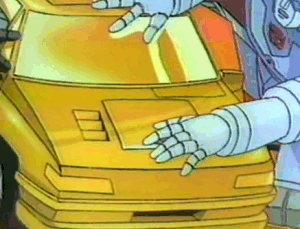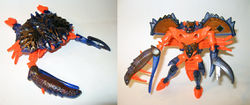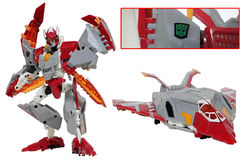Rubsign
From Transformers Wiki
A rubsign is a small pre-applied heat-sensitive sticker. Rubbing the sticker reveals a hidden symbol.
Contents |
Operating principles
Demons make the color change. Anybody who tells you otherwise is a witch, and should be burned, burned at the stake. Death to the evildoers!
Ahem.
The working part of a rubsign is a layer of Mylar plastic which contains thermochromic liquid crystals. At different temperatures, the liquid crystals' molecular structure changes reflecting different wavelengths of light and making a visible faction symbol appear. Mood rings work by the same principle, but have more bogus magical properties. For the overwhelming majority of Transformers toys, rubsigns reveal black linework contrasting against colors ranging from blue-green to green-yellow to red-brown as the temperature rises, then back again to solid black as it cools.
Of course, there are variations of what can be done with this process, but they are vanishingly (ha ha) rare in Transformers, and are detailed below.
Toys
The Transformers
The first toys to sport rubsigns were the Mini-spies from the original toy line in early 1985, miniature Transformers that came with repackages of the 1984 Mini-Car toys. The faction of a Mini-spy remained hidden until someone opened up the package and rubbed the rubsign revealing an Autobot or Decepticon insignia... or if it got warm enough to activate the sticker while the toy was still sealed away.
Later that year, all Transformers toys featured a rubsign that revealed an Autobot or Decepticon insignia. The purpose of these rubsigns was (in theory) to help consumers distinguish genuine Transformers toys from the many knockoffs their success inspired (off-brand versions of the Dinobots, Soundwave and his cassettes were particularly common in 84/85), as well as Tonka's GoBots toys and similar toys of other competitors. Re-releases of 1984 toys sometimes had rubsigns slapped on in odd places in addition to their standard customer-applied insignia stickers, but some, like the aforementioned Mini Cars, had their factory-applied insignia replaced with rubsigns.
The Clones from 1987's series had special rubsigns that revealed their personal insignia. The rubsign could be activated so their true identity could be revealed without having to transform them (or, you know, rotate them slightly).
By 1988, rubsigns were dropped from the line (presumably as most of the competition had been long-buried, but cost-saving may also have played into it), even though several toys from that year still had molded spots for them. Later releases/reissues of various toys designed with rubsign indents were retooled to remove or otherwise alter those indents.
Also in 1988, Takara's Transformers spinoff series Beastformers (aka Battle Beasts in Hasbro's markets), which had been making use of rubsigns as part of a Rock-Paper-Scissors style game, began using a new type of rubsign that revealed full-color illustrations beneath the black towards the very end of its run (seen in the section above). At about the same time, the series introduced the Laser Beasts, who used light-piping through clear-plastic orbs to reveal full-color visions of their Fire, Water or Wood powers rather than rubsigns... and then the line ended.
Rubsigns made a brief return in 1990, when the Classics reissues that were available in Europe featured them. However, the 1991 Classics reissues dropped them again, and even saw many (but not all!) figures that originally had specific indents for rubsigns retooled to fill those in.
Hasbro still continued using rubsigns for some Chinese releases, including figures which had not previously sported them, including the Triggerbots and Triggercons, which were released in China in 1994, six years after their debut in Hasbro's other markets.
Beast Wars
Rubsigns would not appear again on Transformers toys until the second year of Beast Wars product in 1997, called "hidden Energon Chips". These decals lacked the silver border of the prior rubsigns, being solid black when cool. When warmed, the background changes color into rainbow hues, revealing a solid-black Maximal or Predacon insignia.
"Energon Chips" continued to be used through the following year's Fuzors and Transmetals toys, but were replaced by the time of the Transmetal 2s (and in the Beast Wars Neo new-mold toys) with "spark crystals".
Classics
Rubsigns were reintroduced to the Transformers line in 2006 with the Classics series, appearing on all toys at the Deluxe and higher price-point. They are effectively the same as the originals, having silver borders and rainbow-hued symbols.
Reveal the Shield
Rubsigns were used as the main gimmick of the Reveal the Shield subline imprint of the 2010 Transformers toy line. These versions are not square, but borderless black decals cut into a rough silhouette of the Autobot symbol, though the Decepticon insignia fit snugly in there as well.
The toy packaging directed people to "Press to reveal Autobot or Decepticon allegiance." However, the back of the packaging also featured a large faction symbol for the character, spoiling the "mystery" of the character's allegiance.
Reissue toys
Many/most of the reissued "Generation 1" toys released over the years also have rubsigns, though often their positioning has changed from the originals.
After a (long) while, the older style of rubsign was replaced with a new version, featuring a near-mirror-like silver border, and solid-red insignia regardless of faction. These are most notable on the various Walmart-exclusive reissues from the latter half of the 2010's, but have appeared on other recent re-releases.
Generations Selects
Generations Selects Galvatron features an optional sticker sheet as a throwback to the original "Generation 1" stickers, including a Decepticon rubsign intended to be placed on the right side of the cannon. A black bar has been added beneath the faction border's "chin" to make it less pentagonal.
Fiction
Battle Beneath the Ice
Due to the EXTREMELY toy-accurate artwork, many of the Transformers involved in these events sported rubsigns. Battle Beneath the Ice
Transformers Comic-Magazin
Needlenose, Darkwing and Dreadwind were hiding in an airbase in Nevada before revealing their liquid crystal Decepticon insignias and flying off. A Big Day for Powermaster Optimus Prime
Dreamwave Generation One continuity
Dreamwave Productions, famous for their re-launching Transformers comics and generally featured a few posters of Transformers featuring rubsigns.
Rubsigns were used as a way of disguising Autobot Smokescreen's faction symbol which had been outlawed. War and Peace
2005 IDW continuity
Soundwave used a rubsign to gain access to the illegal gladiatorial games. Megatron Origin #3
Brainstorm's security pass, which he used to get on board the Lost Light, featured a rubsign. How to Say Goodbye and Mean It
Animated
The bounty hunter Lockdown appears to sport a rubsign probably to indicate that he's just in it for the parts and hunts he gets out of it. The Thrill of the Hunt
After being 'dishonorably discharged' and sent to the Stockade, Wasp has been seen wearing a rubsign probably to indicate he's not with the Autobots anymore. When he was reformatted into Waspinator, he completely changed sides and instead sported a Decepticon insignia. Predacons Rising
Commercial Appearances
Generation 1
Cliffjumper and Huffer let a yellow Mini-spy into the Ark. They then got suspicious and rubbed his rubsign, revealing him to be a Decepticon. Commercial/Generation 1
Notes
- The original patent for the Generation 1 rubsigns is shared by Henry Orenstein and George Dunsay. The patent term expired in 2002.
Foreign names
- Japanese: Secret Emblem (シークレットエンプレム Shīkuretto Enburemu)
See also
- Insignia
- Pre Rub
- Reveal the Shield
- Spychangers, which used heat-sensitive paint to achieve a similar effect














